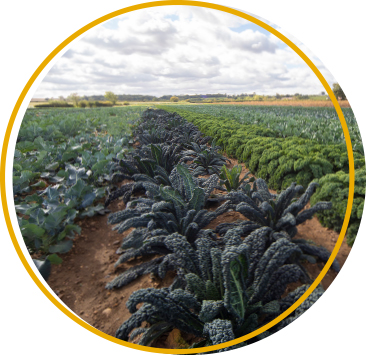Innovation is the key to veg sector success
Targeted, up-to-date technical advice is vital in the high-value vegetable sector, where sub-optimum performance can have a sizeable impact on crop profitability.
Top quality agronomy and innovative technology, backed up by a wide trials network and a substantial R&D budget, are key in helping Agrovista’s agronomists deliver results that count.
All agronomists have experience in other sectors, particularly arable, which can provide some useful synergies when adopting novel techniques.
Improving soil health is an obvious example, says John Allan, head of veg at Agrovista. “This has been a hot topic in the arable sector for a while, but you could argue it is even more beneficial for high-value vegetable cropping.”
Regular soil testing and assessments included in Agrovista’s comprehensive soil health reports help growers influence numerous chemical, physical and biological parameters in their soils, says John.
Precision techniques such as GPS soil sampling are also becoming more popular. “The high density of sampling points provides a very accurate picture of soil nutrient levels and pH, and each point can be repeat sampled, so growers can easily assess the effectiveness of their management regimes in years to come,” he adds.


Cover crops are becoming a more common sight on vegetable units to protect soils from erosion, reduce leaching and improve soil structure.
But there are challenges. “Which species of cover crop has the least negative impact on the following crop or rotation is not always straightforward,” says John. “Some can become potential weeds, or encourage diseases like club root, so care is needed.
“There is also the potential to exacerbate soil-borne nematodes with the wrong choice of cover crop. But some plant species can actually suppress nematodes, so we should take the opportunity to include them whenever we can.”
Fundamental to an integrated production approach, cultural controls and alternatives to traditional chemistry are becoming increasingly important to counter the loss of key actives due to regulatory changes and the cost of maintaining Extension of Authorisation for Minor Use programmes.
Bioscience products are becoming increasing important tools, boosting plant vitality to help crops better withstand stress and the effects of adverse growing conditions, pests and diseases. These products can also reduce the risk of exceeding maximum residue levels (MRLs) and protect the environment to help meet end-user protocols.
“Terra-Sorb Foliar Extra is a blend of 21 readily available amino acids helping plants make better use of existing resources,” says John. “Used with broad-spectrum foliar nutrition it can turn a crop around in no time.
“It is particularly useful on baby leaf and other salad crops under stress, and it came into its own this year on wet, compacted, anaerobic seedbeds that left a lot of crops struggling for colour.”
Calfite Extra contains calcium phosphite, which stimulates root and biomass growth. It also contains L-PGA (pidolic acid) to increase nitrogen assimilation within the plant.
“This is particularly useful in salad crops to help boost early root development and establishment, setting the crop up for healthy growth and colour,” says John.
Turning to the wider industry, funding remains key to help prevent the loss of further key crop protection products. “Horticulture Crop Protection took on the residual fund from AHDB Horticulture, so at least there is a fighting fund for EAMUs,” says John.
“Crop groups within HCP are very proactive in getting members on board to identify their priorities. I would urge all growers to contribute into this vital area.”
The development of alternatives to herbicides remains key. Some, like image-guided mechanical weeders are already proven in row crops, but high-density crops such as baby leaf salad crops need solutions to combat important weeds like fat hen and groundsel.
“Obviously these crops can’t be hoed and we only have access to a very restricted choice of pre-emergence herbicides,” says John. “Laser weeders and high-intensity light weeders are in development. They are currently very expensive, but hopefully could become viable options.
“Baby leaf crops have to be hand weeded when weeds are present, which is a massive cost. An autonomous machine would be the perfect solution and, notwithstanding the high cost, the return on investment could make them affordable.”
Problem pests
Wireworm is the pest that everyone is talking about as control options dwindle, says John. “The gradual loss of soil-applied insecticides and the adoption of minimum tillage, along with grassy margins and green covers, are likely to be contributing to its increase.”
Rotational control is key, although cover crops like mustard planted ahead of prone crops like potatoes, brassicas, carrots, lettuce and baby leaf crops have been shown to reduce numbers.
Bean seed fly is another ongoing issue, affecting emergence in peas, beans, alliums, lettuces, beets and spinach among others, particularly when later sown. Force seed treatment is a useful chemical control but is not currently approved for use.
“Careful seedbed preparation is required,” says John. “Flies are attracted to decaying organic matter so timely destruction and good burial of previous crop residues is important.
“Stale seedbeds are very effective as flies like freshly cultivated loose land.
Bean seed fly occurs from April through to September, but there is no reliable forecast available.”

